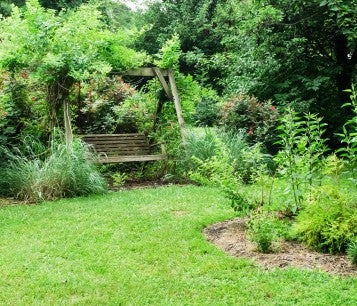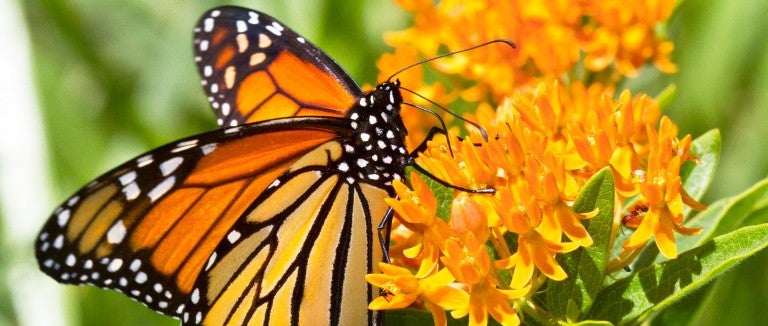Much of what we do in the name of aesthetics comes at a cost to our overall well-being. From fad diets to chemical peels to cosmetic surgeries, beauty routines attempt to squash what’s natural in favor of an unattainable and short-lived “otherness.”
The mindset isn’t limited to the treatment of our own species. Exercising similar control over our landscapes, we import plants from across the globe—and alter those already here—to satisfy an ever-evolving palette of arbitrary human preferences: shorter height, larger flowers, stronger fragrance.
In thinking only of our own desires, we disregard the health of wild animals: the bird who needs a certain type of nesting habitat, the bee who extracts nectar from particular flower structures or the caterpillar who dines on only one species.
The latest headline-grabbing example of animals’ dependence on native species is the monarch butterfly, whose populations have decreased by 90% in 20 years because of the loss of milkweed, its caterpillar host. But most other plant-eating insects also depend on specific types of plants for their survival, and most birds rely on those insects to feed their young.
It’s not hard to see the chain reaction. Landscapes dominated by nonnative plants support significantly fewer breeding bird species, writes entomologist and wildlife ecologist Doug Tallamy in The Living Landscape, written with Rick Darke. And about half the U.S. population now lives in suburbs, where the typical property has 90% less tree biomass than a natural woodlot, he reports. Too often, the few species we do plant have a doubly negative impact, offering sparse nutrients to native fauna while smothering native flora.
What’s an animal lover to do?
We can start by creating “places in which animals and plants can successfully reproduce,” Tallamy writes. “That is, our yards and corporate landscapes must be ecologically enriched to the point where they can support entire life cycles of local biodiversity.”
Just as conscientious consumer choices help farm animals and pets, more thoughtful plant purchases sustain wildlife. As Vincent Vizachero of Blue Water Baltimore’s Herring Run Nursery notes, “Landscapes need to be more than pretty faces.”
Even planting one native each month provides a lifeline, says Andrea DeLong-Amaya, horticulture director at the Texas-based Lady Bird Johnson Wildflower Center. Replacing problem species is a great step toward creating beauty that’s more than petal-deep.
A humane backyard is a natural habitat offering wildlife plenty of food, water and cover, plus a safe place to live free from pesticides, chemicals, free-roaming pets, inhumane practices and other threats. And it's so easy to build!

Plant This: Native trees
Jeff Beacham, president of the South Carolina Native Plant Society, recommends planting hawthorns, red maples, sugar maples, oaks and serviceberries. Downy serviceberry (Amelanchier arborea), which feeds pollinators, is also a favorite of Kim Eierman, owner of EcoBeneficial and a teacher at the New York Botanical Garden. On her suburban property—an “ecological oasis in an ecological desert,” she says—cedar waxwing birds visited for the first time after she planted apple serviceberries years ago.
The fruits are so nutritious that Native Americans used them in an early version of a PowerBar, said Massachusetts environmentalist Russ Cohen, author of Wild Plants I Have Known … and Eaten, in a presentation by the Ecological Landscape Alliance. Though birds devour the fruit, “there’s plenty of food for everyone because they can eat from the upper branches and I can eat from the lower branches,” he says.
Not That: Exotic escapees
Many invasive plants once considered tame garden species have escaped cultivation. The widely sold Bradford pear tree, originally from China, is so out of control across the eastern U.S. that “I can show you meadows now so thick with Bradford pears you can’t walk,” Beacham says.
Plant This: Native grasses
Many grasses and sedges feed caterpillars and provide seed and nesting opportunities for other animals. Grassland birds rely on them for their very survival: Instead of flying away from predators, bobwhites, meadowlarks and others use “escape runways” among warm-season bunchgrasses, Tallamy notes.
Depending on your region, options could include switchgrass, sideoats grama, Indiangrass, purple lovegrass, Eastern gamagrass, little bluestem, pink muhly, prairie dropseed and wavy hairgrass.
Not That: Nonnative, invasive grasses
Recent decades brought new appreciation for grasses reminiscent of American prairies. Unfortunately, commonly used species—including Chinese silvergrass (Miscanthus sinensis) and fountain grasses—aren’t from the U.S. The thick stands of Chinese silvergrass make it nearly impossible for grassland birds to flee from danger.
Often marketed as “ornamental,” exotic grasses invade habitat from the Eastern woodlands to the Midwestern grasslands. Two nonnatives—one originally a garden plant and another imported to feed cows—are threatening Arizona’s desert habitats.
Plant This: Fruiting natives
Think blueberries, viburnums, plums, roses, dogwoods, beautyberries and hollies. In Texas, one of DeLong-Amaya’s favorites is possumhaw holly, which draws flocks of cedar waxwings in late winter.
Because they’re so well-adapted, native vines are even more tropical-looking than the exotics we so often admire. Look for coral honeysuckle and Carolina jessamine, both of which attract hummingbirds, and passionflower, a bee magnet.
Not That: Scary berries
The sweet smell of Asian honeysuckle vines and bushes belie their tendency to smother natives. While birds with broad-ranging diets spread the berries, those with specialized needs avoid honeysuckle, further limiting local diversity. And researchers fear the plants harm species nesting in them; they’ve seen cardinals experience more predation and believe the berries may have less nutritional value than those of native plants.
Many other frequently sold berry bushes—Japanese barberry, nandina, pyracantha, burning bush and autumn olive—join invasive honeysuckles on the list of America’s Least Wanted.
Plant This: True originals
Plant milkweed, Joe-Pye weed, asters, goldenrod and other natives to feed butterflies and many other animals. As Eierman of EcoBeneficial says, “Plant it and they will come.”
Not That: Lookalikes and deceivers
Be wary of cultivars, plants bred for certain traits and identifiable when the last word of a name appears in single quotes (e.g., Rudbeckia fulgida ‘Goldsturm’). While some carry high wildlife value, others appear to have lost useful traits. Donna VanBuecken, executive director of Wild Ones, a nonprofit devoted to native landscaping, has seen this firsthand: A patch of ‘Goldsturm,’ a cultivar of black-eyed Susan, attracts no wildlife near her Wisconsin patio, while the straight species in her backyard prairie is covered in butterflies.
Avoid butterfly bush, which overruns habitat and provides little of its own. Though the flowers attract butterflies, the leaves don’t feed a single caterpillar. Such nonnatives that did not coevolve with insects offer “a false ecological promise,” says Eierman, practically guaranteeing a dearth of future butterflies.
Want more content like this?
This was written and produced by the team behind All Animals, our award-winning magazine. Each issue is packed with inspiring stories about how we are changing the world for animals together.
Learn MoreSubscribe
